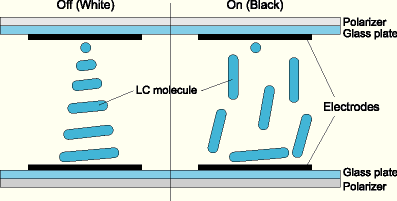Comparison Of 15" LCD Monitors - Part I
TN + Film (Twisted Nematic + Film)
Figure 1: In TN + film panels, the liquid crystals are arranged at a right angle to the filter. The "film" part of the name comes from the extra layer added to the panel in order to increase the viewing angle.
TN + film is the easiest technology to apply. Twisted Nematic technology is already getting on in years - you'll find it used in most of the TFT panels sold in the past several years. In order to improve the legibility of their panels, the designers added a film layer to them - the viewing angle subsequently went up from 90° to 150°. As efficient as this film might be, it unfortunately has no effect on the contrast levels or response time, both of which continue to be very poor.
So, in theory at least, TN + film displays are really low-end solutions. The manufacturing process is as refined as those used for previous TN designs. Currently, there are no cheaper solutions than TN + film.
Here's how it works: if the transistors apply zero voltage to the subpixels, the liquid crystals (and with them the polarized light they allow to pass) rotate 90° horizontally between the two plates. And since the polarizing filter on the second plate is offset from the first one by 90°, the light can pass through it. If the red, green and blue subpixels are fully illuminated, they will combine to create a white dot on the screen.
If a voltage is applied, in our case a vertical electric field, it will destroy the helical structure of the crystals. The molecules will then try to align themselves in the same direction as the electric field. In our example, that means that they will end up being perpendicular to the second filter. In this position, the polarized incident light can't pass through the entire subpixel (ON position). The white dot then becomes a black one.
There are certain disadvantages to having a TN display.
First, designers struggled for an eternity trying to coax the liquid crystals to stay perfectly perpendicular to the polarizing filter when the voltage levels had peaked. This explains why older screens are virtually incapable of displaying black perfectly.
Get Tom's Hardware's best news and in-depth reviews, straight to your inbox.
Second, if a transistor fails, it can no longer apply any voltage to its three subpixels. That makes sense, considering what we just discussed. So zero voltage means a white dot on the screen. This explains why LCD pixels that have "died" are still very bright and visible.
For 15" monitors, there's really only one other technology than can rival TN + film technology - MVA (explained later). This technology, more expensive than TN + film, is theoretically supposed to be better in almost all areas. This isn't quite true, though, since TN + film is superior to MVA in some areas.
Current page: TN + Film (Twisted Nematic + Film)
Prev Page Liquid Crystals, An In-Between Stage Next Page IPS (In-Plane Switching Or Super-TFT)